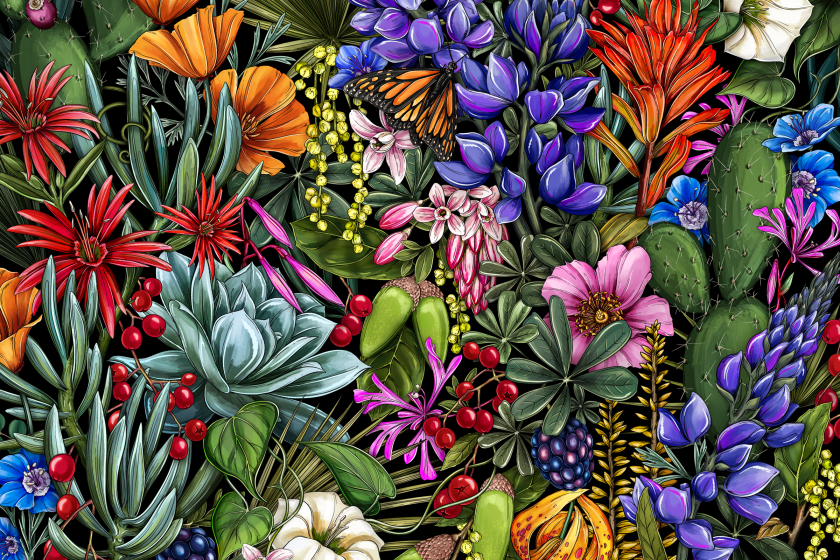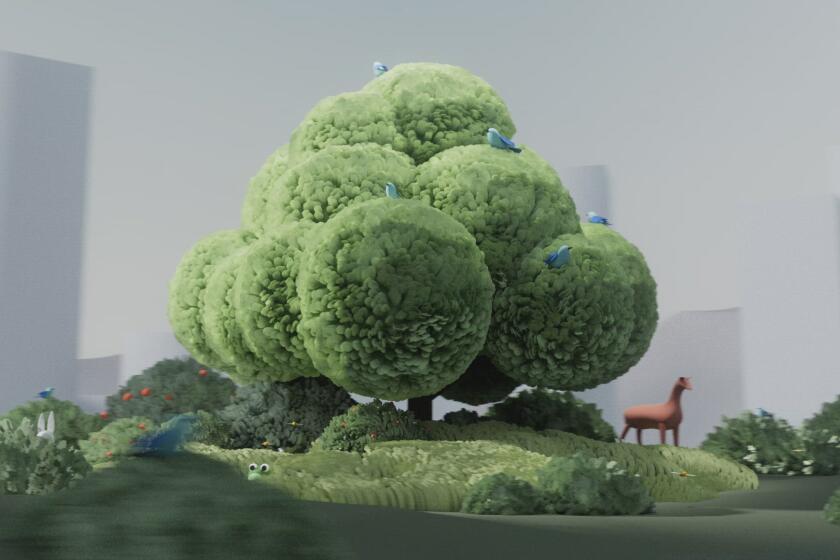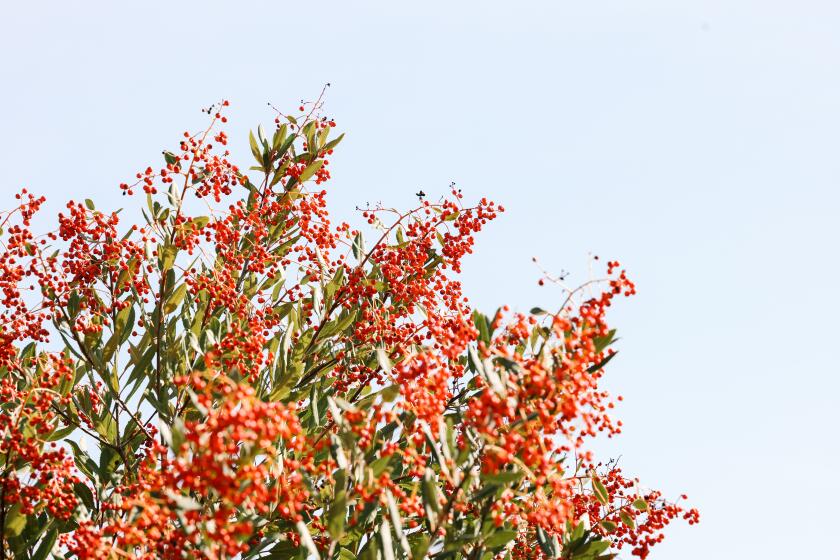
- Share via
How do you create a convincing span of nature over one of the state’s busiest freeway corridors so that wildlife like L.A.’s famous, ill-fated cougar, P-22, can cross unscathed?
First you build a nursery and collect a million hyperlocal seeds.
This is not hyperbole. After Katherine Pakradouni was hired in January 2022 to grow the plants for the coming Wallis Annenberg Wildlife Crossing in Agoura Hills, she spent much of the year combing the hills within five miles of the crossing, collecting — yes — more than a million seeds from native plants.
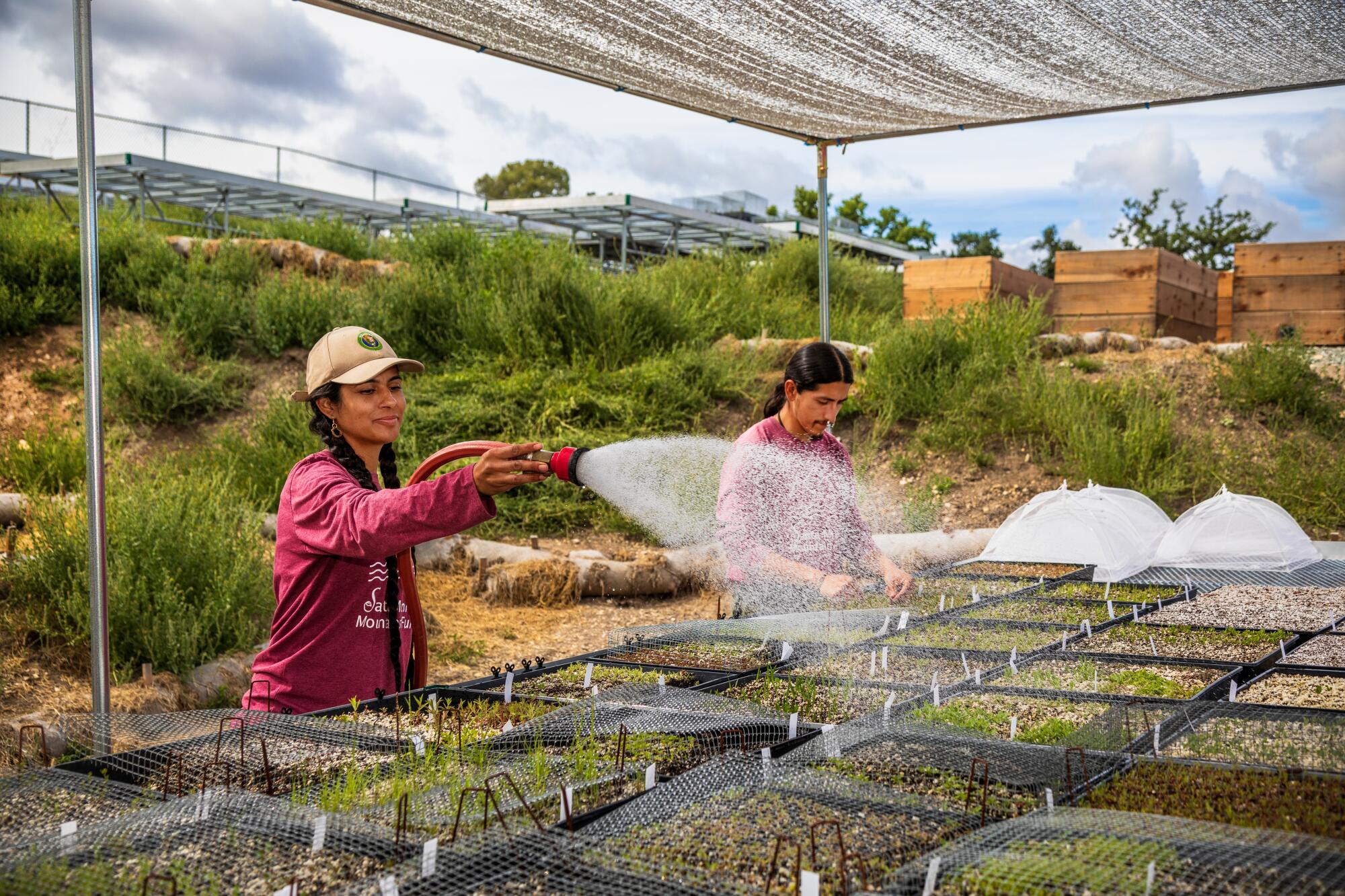
Before she went collecting, she had to build a special nursery near the north side of the crossing, where she and her team are planting those seeds to grow trays and trays of the native flora that will fill the crossing when the concrete superstructure is completed late next year.
Here are the best retail native plant nurseries in Southern California to help you create a habitat for birds and pollinators in your yard or even on a patio.
The center supporting beams are already visible on the 101 Freeway, just west of the Liberty Canyon Road exit at the western edge of Los Angeles County. Once the supports are in place, the crossing will be assembled from 84 precast concrete girders, which are being constructed in Perris, said Robert Rock, a landscape architect for Chicago-based Living Habitats and lead designer for the project.
Those girders are scheduled to be installed over several weeks, starting this fall, between midnight and 5 a.m. The freeway will never be closed completely, Rock said. Using precast girders means the span can be constructed first on one side of the freeway and then the other, so traffic can be diverted in the wee hours to other lanes.
Once the drainage system is completed and the soil is brought in, planting can begin. The $92-million project — split 50/50 between public money and donations to the National Wildlife Federation and its Save L.A. Cougars fund, including $26 million from Wallis Annenberg and the Annenberg Foundation, its largest contributor — is scheduled for completion at the end of 2025.

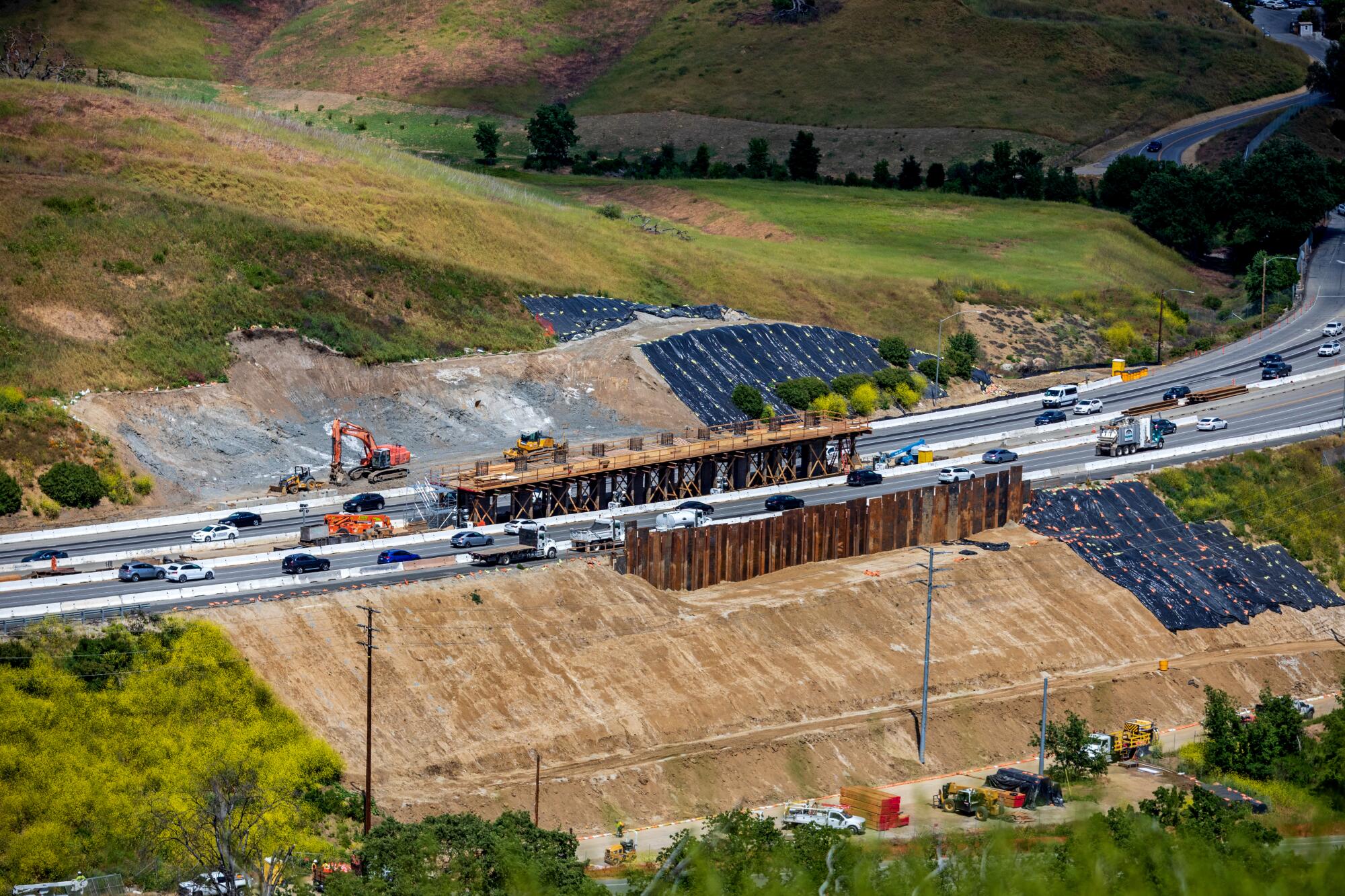
The design team’s plant palette for the crossing includes 30 species — local sages such as black sage, white sage and purple sage; buckwheat varieties including California buckwheat, long-stem buckwheat and ashy leaf buckwheat; wild grape; narrow-leaf milkweed; California bush sunflower; deerweed; penstemon; and needle grass and other grasses. They’ll also include wildflowers and shrubs like toyon, laurel sumac and ceanothus.
And Pakradouni’s not just growing hyperlocal native plants. In the project’s nursery, she and her small staff are cultivating microbes and mycorrhizal fungi collected from soil near the site, to help the plants absorb the water and nutrients they need from the soil.
California native plants have many pros, but their potent scents are the biggest draw of all. Gardening experts share the most fragrant native plants.
It’s not exactly Eden, but when it comes to re-creating nature, Rock and his team are literally leaving no stone unturned.
“Whether you’re talking about a nursery or the creation of landscapes in general, so much emphasis is put on what exists above the ground surface ... but if you’re not also thinking about how those plants are connecting with the ecosystem below the ground, you’re only doing half your homework,” said Rock.
“To have a self-sustaining landscape, we have to re-create the mycorrhizal fungi in the [local] soil and the beneficial microorganisms as well, the earthworms and little soil bugs. ... Katherine had the brilliant stroke to call it an ‘earth-based sourdough starter.’”
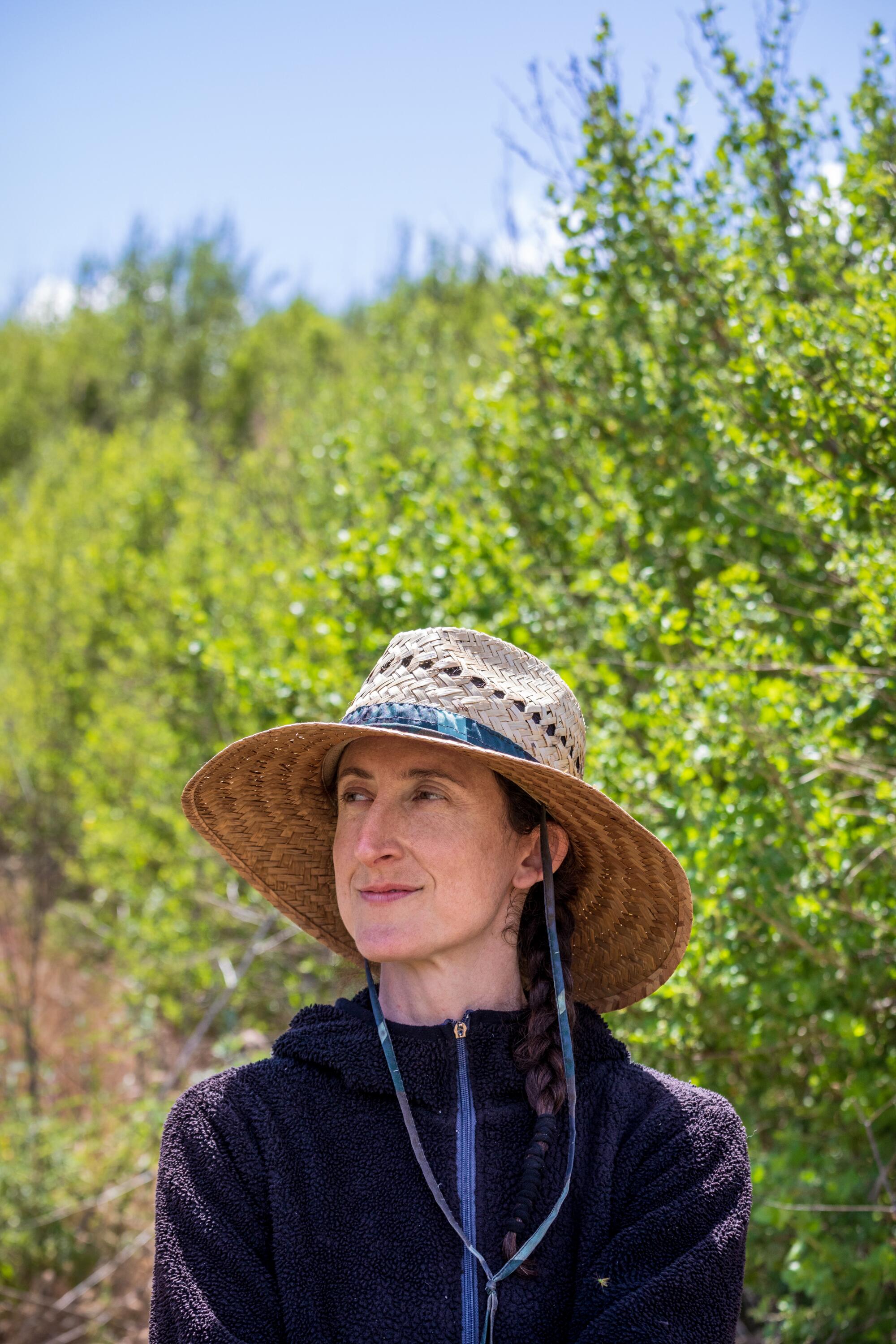
Pakradouni was hired because of her experience building native plant nurseries from scratch for Grown in L.A. and the L.A. Parks Foundation at Griffith Park. And that was among her first tasks once again: setting up a nursery on a hillside near the site designed to grow plants for the crossing, finding a way to bring in reclaimed water for irrigation, setting up a trailer on the site powered by solar panels to keep the seeds safely stored and constructing about 50 metal-mesh-topped tables to protect her future brood from disease.
“This isn’t done by a lot of nurseries because of the expense involved, but it’s really critical for plant health and pathogen exclusion. Water-borne diseases spread from plant to plant, but all these plants will be elevated 2 to 3 feet off the ground so they will never sit in pooling water,” she said. “And the height keeps the bunnies from eating all the plants.”
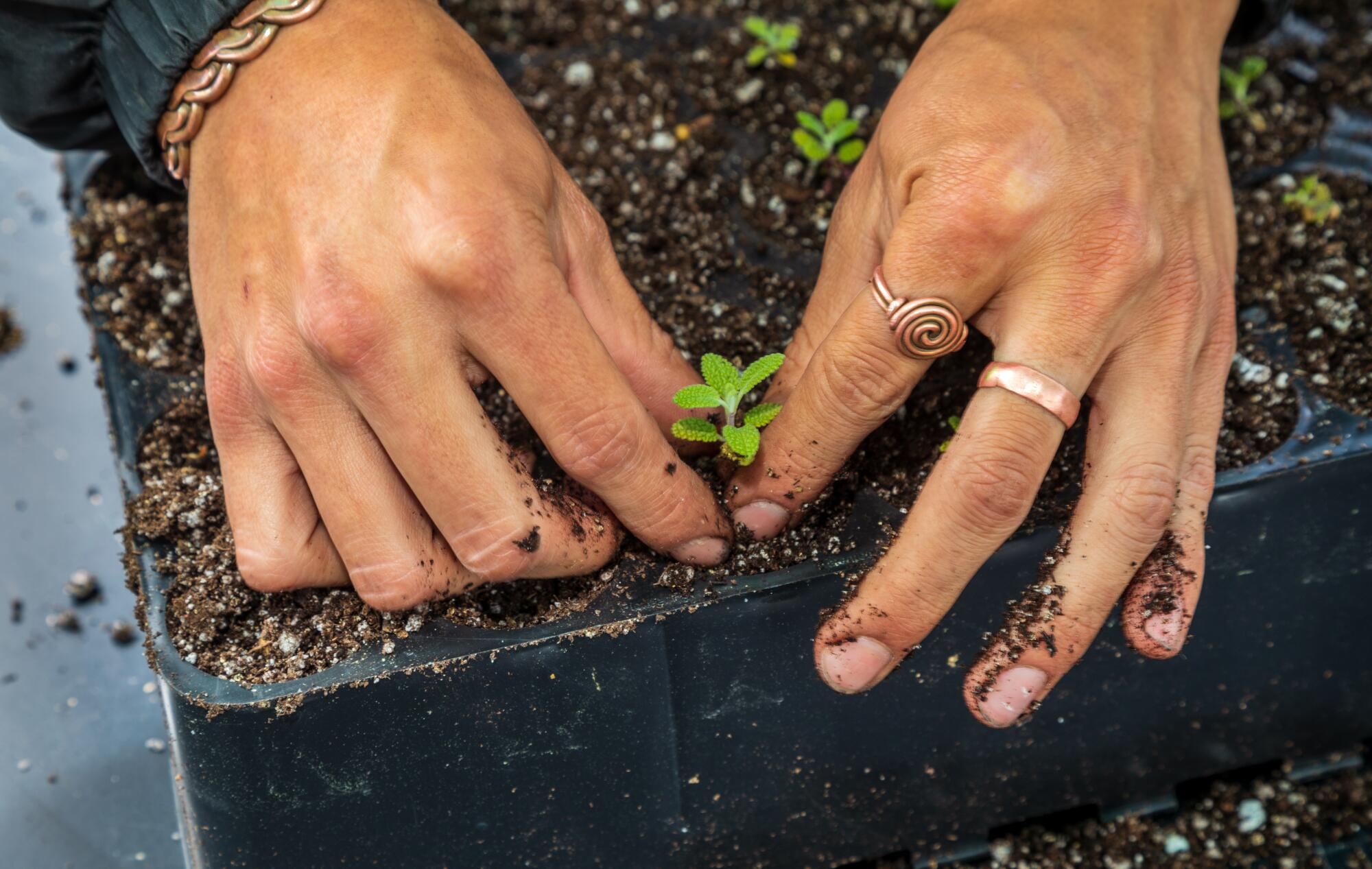
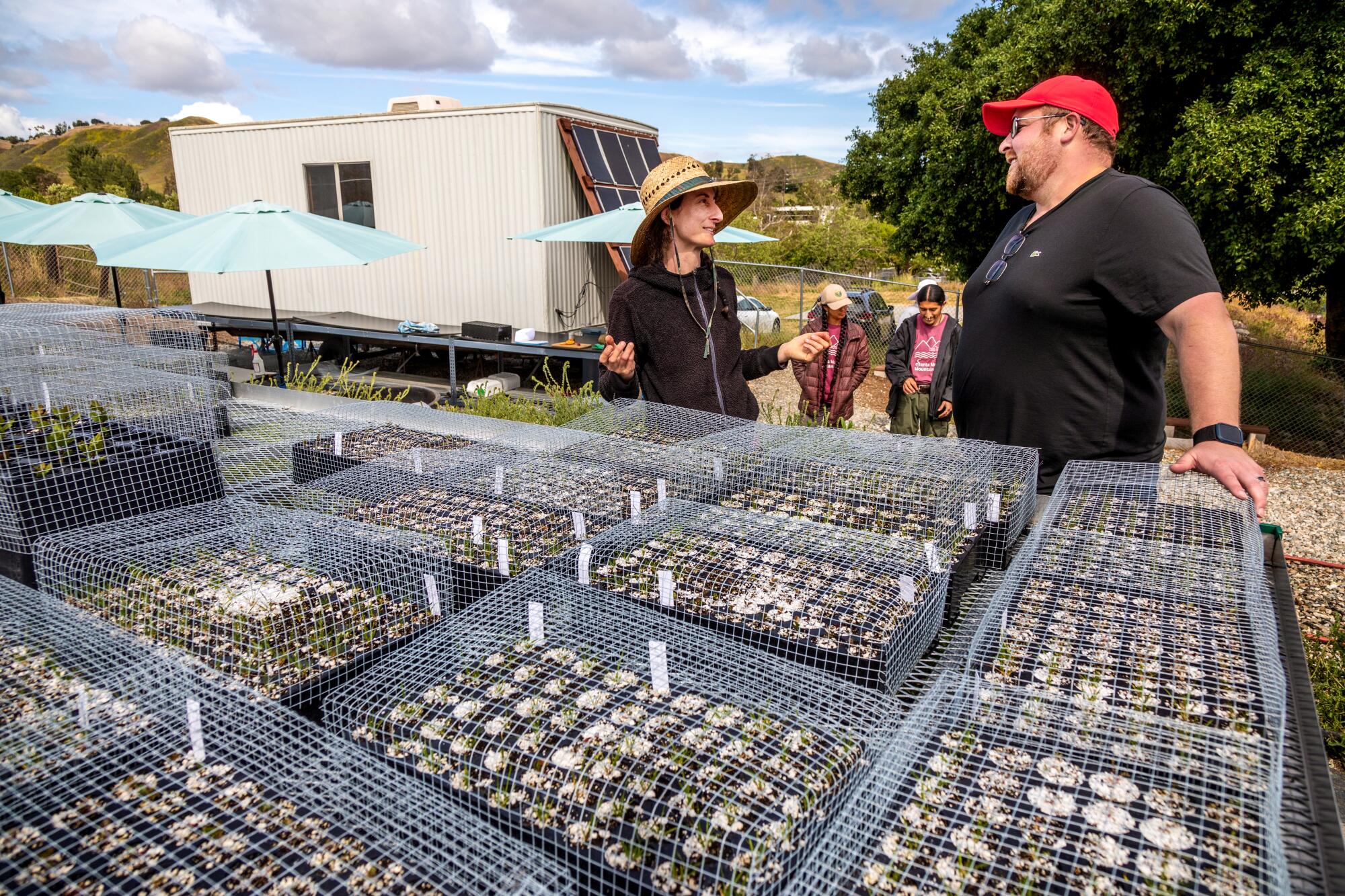
To further protect against disease, Pakradouni is sterilizing any recycled pots — the tiny seedlings at the nursery eventually will be transferred to gallon pots so they’re a good size for transplanting on the crossing. And she’s using air-pruning pots with slits on the sides to encourage seedling roots to branch more inside the pot rather than circling the edges of a plastic wall.
“Conventional pots are solid, so you end up with root-bound plants,” she said. “We’re trying to make the seedlings as vigorous and robust as possible before they’re bumped up to the larger pots.”
The scope of the project is a little mind-boggling, because Pakradouni isn’t just raising plants to fill the 174-foot-wide structure — wider than a football field — that will span 10 lanes of the 101 freeway.
Los Angeles needs micro forests to help fight climate change and animal extinctions, says horticulturist Katherine Pakradouni.
Deep-rooted plants like trees can’t be planted on the structure itself, which will have soil depths of only 1 to 4 feet. But the nursery will eventually grow enough plants — including oaks and other trees — to fill about 12 acres on either side of the structure, so the crossing feels seamless — more like walking over a hill than crossing a bridge.
The width of the crossing and the large variety of plants are important because of the many animals it will serve. Smaller animals need cover as they make the crossing to feel safe from predators in the sky and on the land, but deer want areas with a clear line of vision, Rock said, so they can watch for predators lurking in the scrub.
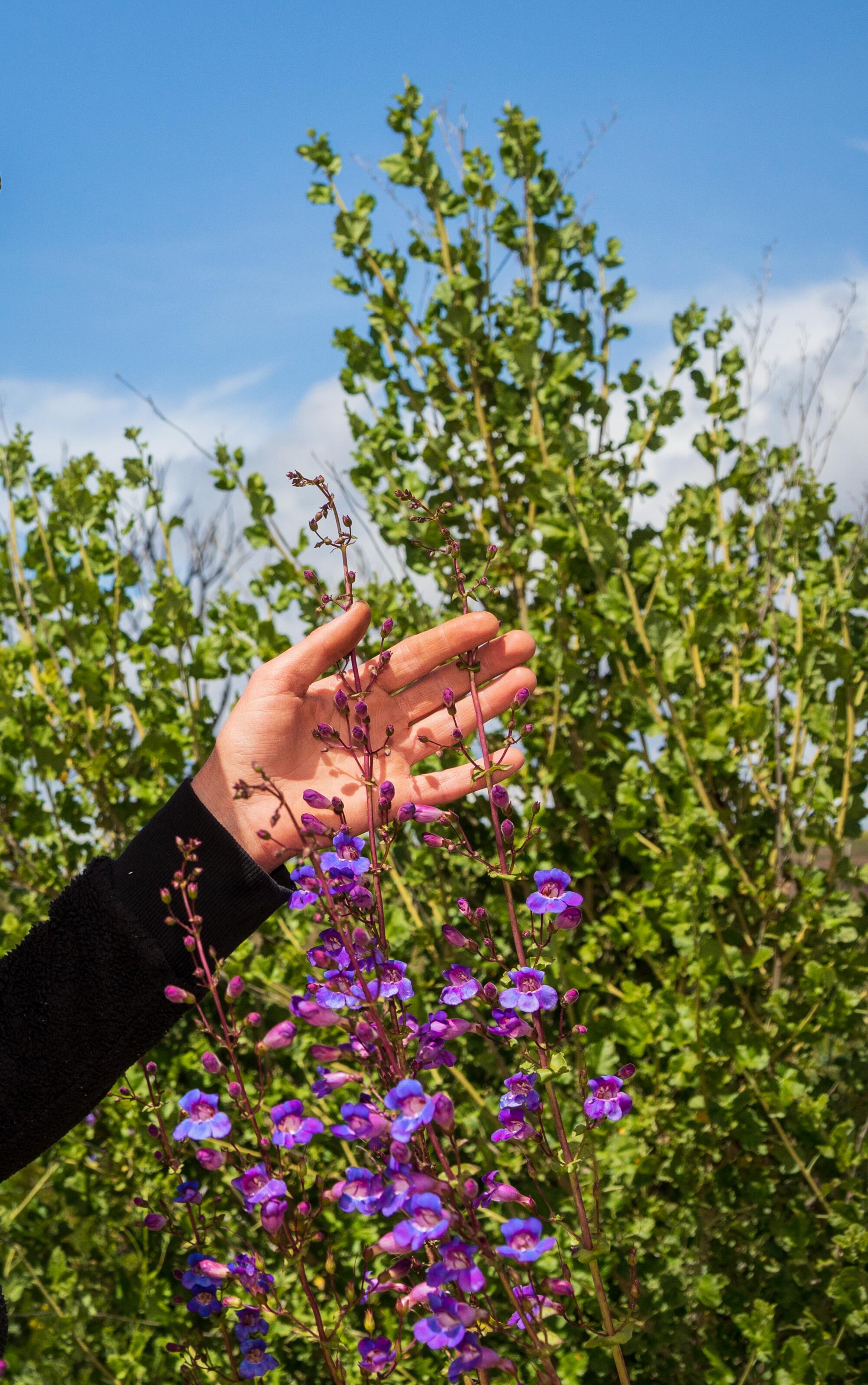
The crossing isn’t meant to be a “funneling moment” that directs animals across a narrow bridge from one side of the freeway to the other, Rock said. “We’re trying to capture the scale of space, so we can accommodate the widest array of species.”
The walls of the crossing will be planted with wild grape to help cover the structure and reduce traffic noise. Mesh galvanized-steel baskets filled with stones will create retaining walls along the freeway near the approaches to absorb more freeway noise. These gabion walls will support the berms of soil along the approaches and won’t be visible to the wildlife, who will only see what appears to be a continuation of the hill, Rock said.
The project officially began with the groundbreaking ceremony on April 22, 2022, but design work began before the pandemic, Rock said, and the conception dates back more than 30 years. At that time, Fran Pavley, environmental policy director of the USC Schwarzenegger Institute, was the first mayor of Agoura Hills and had the foresight to work with the Santa Monica Mountains Conservancy to ensure the land on either side of the crossing was kept free from development.
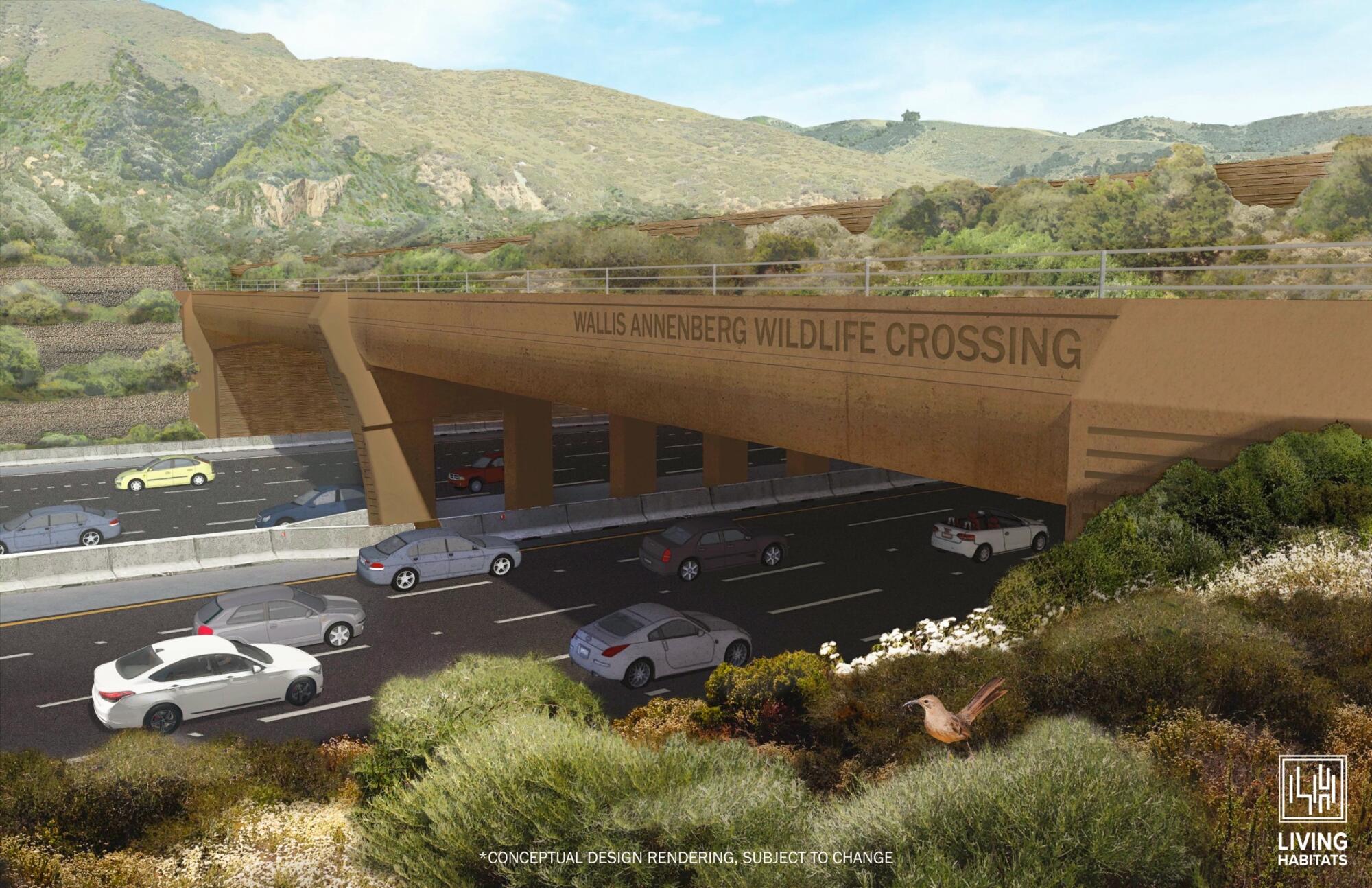
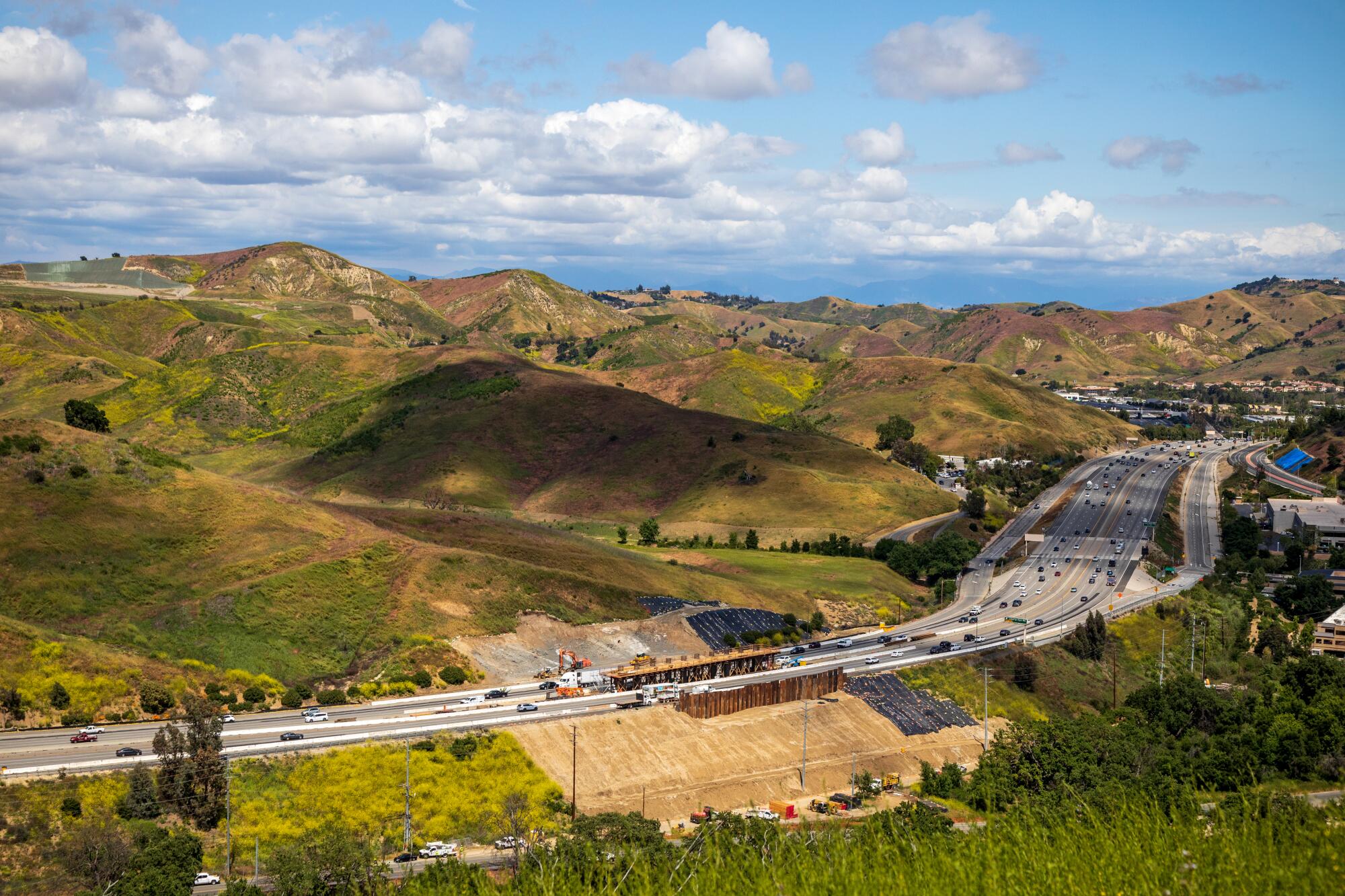
Coordination is a huge part of Rock’s job since the project has five core partners in its Liberty Wildlife Corridor Partnership: the California Department of Transportation, the National Wildlife Federation, Mountains Recreation and Conservation Authority/Santa Monica Mountains Conservancy, the Resource Conservation District of the Santa Monica Mountains and the National Park Service. And the teams working on creating this corridor are diverse and extensive, Rock said.
“Not mentioning the 100 people I communicate with at Caltrans who are preparing the final engineering drawings and overseeing the construction, we have folks on our design team covering everything from wildlife biology — large mammal, small mammal and herpetologists — to soil scientists, mycologists and stream specialists — limnologists — who study fresh water.”
The crossing actually involves multiple projects, said Rock. Before the span itself can be erected, the designers are moving a huge hill of soil on the north side that was deposited there in the 1950s, when the 101 was realigned to become a “modern” freeway. That soil will move once again to create a berm on the south side of the crossing, to continue the hill effect over Agoura Road.

December is prime planting time for native plants in Los Angeles, and habitat restoration projects are looking for volunteers ... or is it the other way around?
For the record:
1:25 p.m. June 21, 2023An earlier version of this story incorrectly identified the biological name of the Catalina Mariposa lily as Castilleja exserta in a photo caption. The correct name is Calochortus catalinae.
A tunnel will be built through that south-side berm to allow traffic to flow on Agoura Road. And once the soil is gone on the north side and the area restored to its original grade, engineers will be re-creating the natural drainage corridor for Liberty Canyon Creek along the freeway. Wildlife like to follow stream corridors, said Rock, and this will help direct animals to the crossing as well as provide a channel for runoff.
Excess moisture on the crossing will be directed to a small unnamed creek on the south side of the crossing, between the freeway and Agoura Road.
“Water sitting on a bridge is bad for many reasons, so we want to make sure it drains off the bridge so it doesn’t cause problems in the long run,” Rock said — and a small creek “is a more ecologically sensitive and beneficial solution for runoff” than dumping water in a storm sewer.
Ultimately, he said, the designers are “trying to restitch a fractured landscape” altered years ago with the construction of the freeway, which makes crossings deadly for roaming animals.
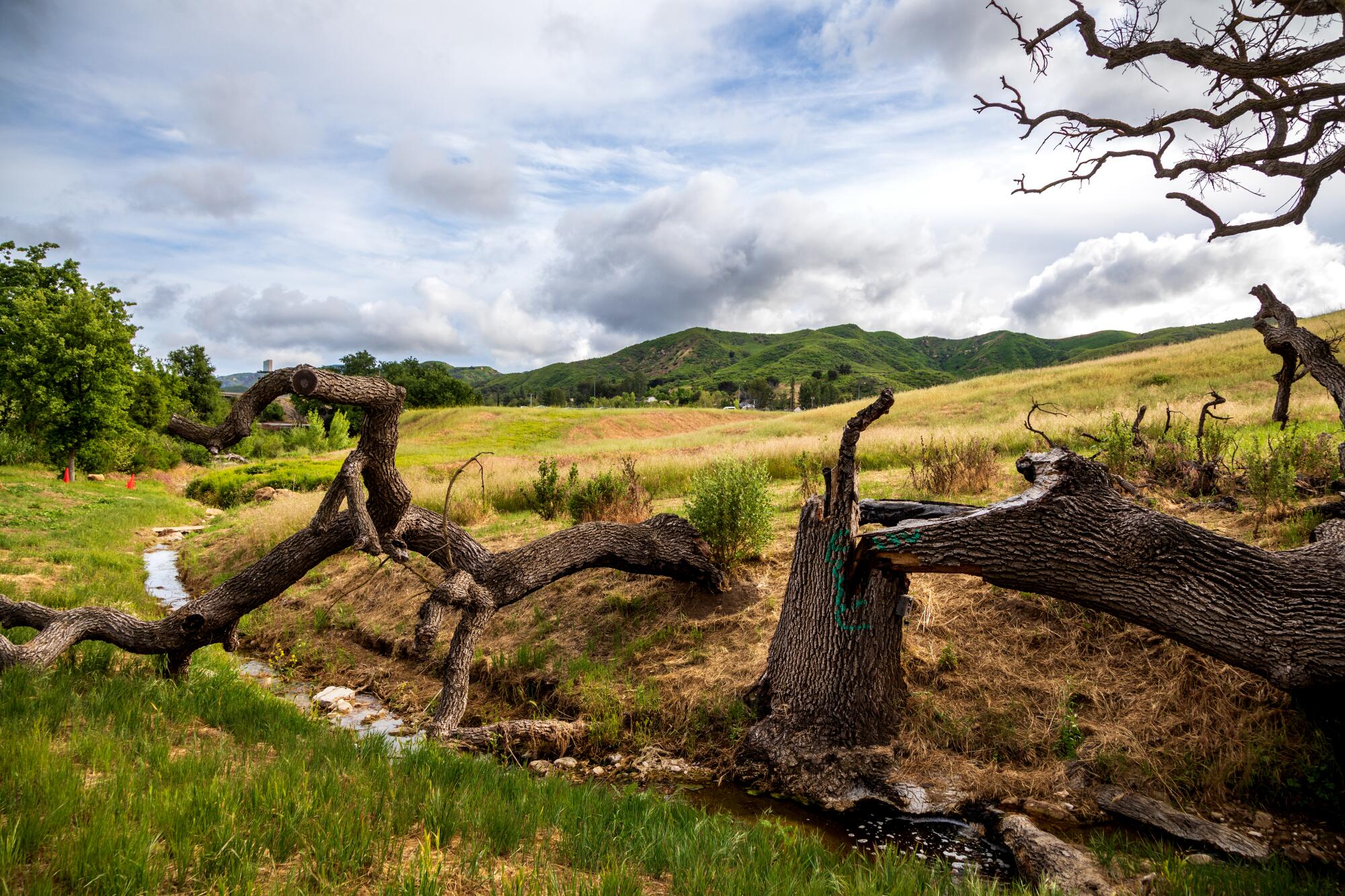
The goal is to keep larger animals moving over the crossing, but there are small animals and insects that may live their whole lives on the bridge, creatures who rarely travel more than a few meters or kilometers from where they were born. For those, Rock said, “We’re just providing a new piece of tapestry for them to explore.”
Humans will be the only animals not welcome on the crossing — although ultimately there will be trails and vista points nearby for hikers to look down on the newly “stitched” landscape.
There’s a steep trail now off Agoura Road just west of the Liberty Canyon exit for hikers who want to climb up the hill to watch the project’s progress, but those who prefer a tamer option can always tune in to the project’s webcams to watch the construction proceed.
More to Read
Sign up for The Wild
We’ll help you find the best places to hike, bike and run, as well as the perfect silent spots for meditation and yoga.
You may occasionally receive promotional content from the Los Angeles Times.
